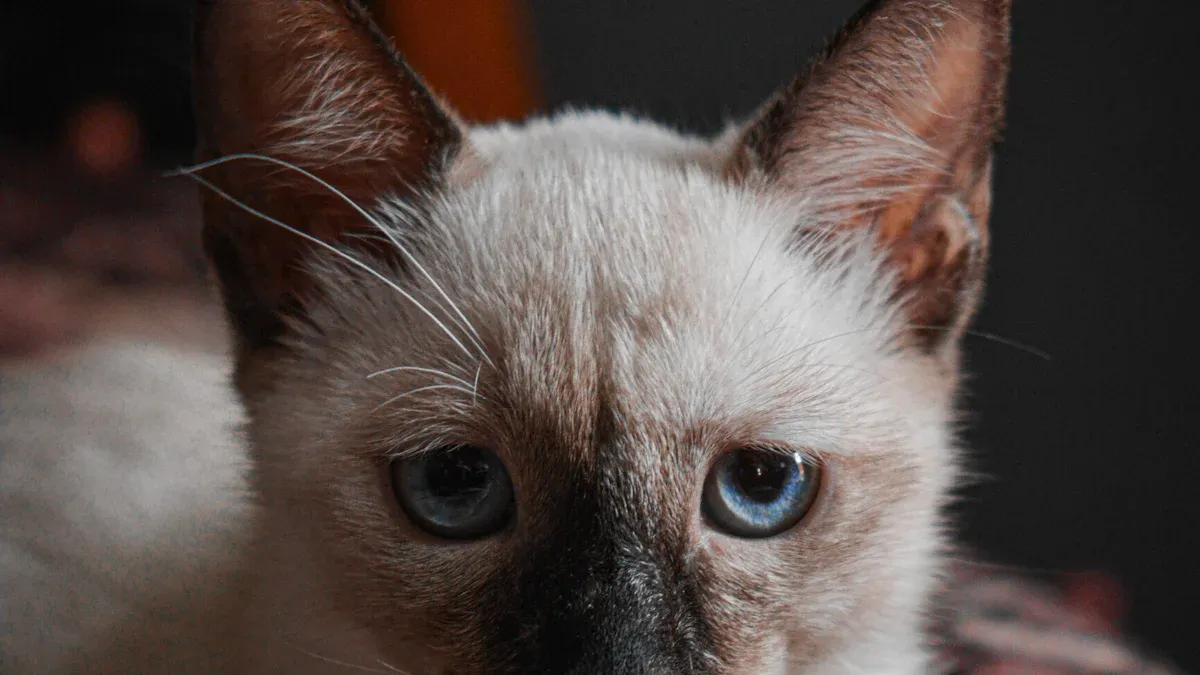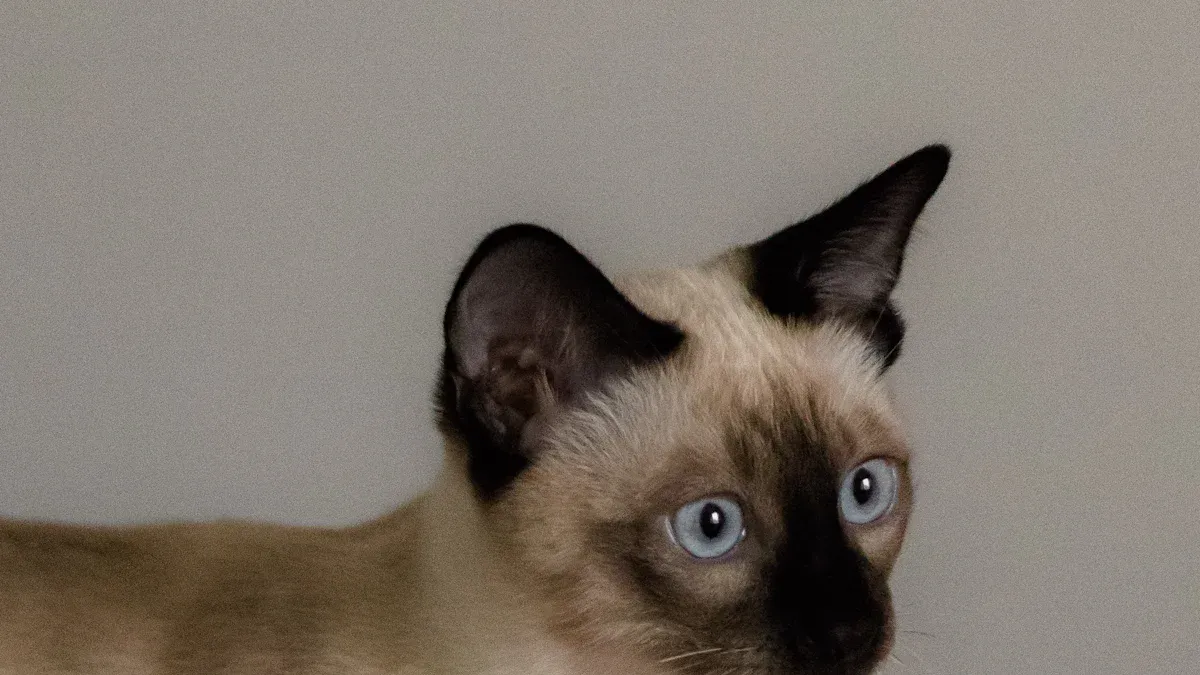
Burmese cats captivate with their rich, velvety coats in shades like sable, champagne, blue, and platinum. These stunning colors owe their beauty to the Burmese gene (cb), which plays a unique role in reducing pigment production. This gene transforms black into warm brown tones and lightens other colors, creating the signature look of the breed. Interestingly, the effects of this gene are most noticeable in kittens, whose coats often appear lighter before darkening with age. Originally, all Burmese cats were dark brown, but over time, selective breeding introduced the diverse coat colors we admire today.
Key Takeaways
Burmese cats have lovely colors like sable, champagne, blue, and platinum. Each color has special features.
The Burmese gene (cb) lowers pigment, giving them warm brown and light shades.
Kittens are born with light fur that gets darker as they age. This shows how genetics affect their looks.
Breeders should focus on keeping Burmese cats healthy instead of just coat colors. This helps avoid genetic problems.
Knowing genetics can help guess kitten coat colors and keep diversity for healthier cats in the future.
Overview of Burmese Cat Colors

Traditional Colors of Burmese Cats
Burmese cats are famous for their classic coat colors, each with its own unique charm. These traditional shades include sable, champagne, blue, and platinum. Let’s take a closer look at what makes each one special:
Color | Description |
|---|---|
Sable | A deep chocolate-colored coat, darker along the back and tail, fading to a coffee color on the underbelly. |
Champagne | A creamy honey-colored coat with darker shades on the face, paws, ears, and tail. |
Blue | A stunning shade that ranges from dusty gray to vibrant periwinkle, often paired with striking green eyes. |
Platinum | The lightest color, similar to champagne but with less defined dark tones on the face. |
The sable coat is the most iconic of all. Its rich brown tones give Burmese cats their signature look. Champagne, on the other hand, offers a softer, honey-like hue that’s equally captivating. Blue and platinum add a cooler touch to the palette, with their silvery and grayish tones. These colors are not just beautiful—they’re also a testament to the unique genetics of Burmese cats.
Rare or Uncommon Variations in Burmese Cats
While the traditional colors are stunning, Burmese cats also come in some rare and experimental variations. These include tortoiseshell patterns, diluted colors like lilac and cream, and even experimental shades such as red and seal point. Here’s what sets these apart:
Tortoiseshell Patterns: These coats combine patches of black, brown, and orange, creating a mosaic-like effect. They’re less common but incredibly eye-catching.
Diluted Colors: Lilac and cream are softer versions of traditional shades. Lilac has a purplish tint, while cream offers a pale, warm tone.
Experimental Colors: Red and seal point are newer additions. Red coats have a rusty, coppery hue, while seal point features darker extremities, similar to Siamese cats.
These rare variations often result from genetic mutations or selective breeding. For example, the Burmese gene (cb) reduces pigment production, transforming black into brown and lightening other colors. This gene’s effects are more pronounced in warmer body areas, which is why you might notice darker extremities in some Burmese cats.
Whether you prefer the classic sable coat or a rare lilac variation, Burmese cats offer a stunning array of colors to admire. Their coats are not just visually striking—they’re a fascinating blend of genetics and beauty.
Genetics of Burmese Cat Colors

The Role of Melanin and Pigments in Burmese Cats
Eumelanin and Pheomelanin in Coat Color
Have you ever wondered what gives Burmese cats their stunning coats? It all comes down to two pigments: eumelanin and pheomelanin. Eumelanin is responsible for black and brown shades, while pheomelanin creates red and orange tones. In Burmese cats, these pigments interact in fascinating ways. For example:
The russet coat color shows how eumelanin and pheomelanin work together. Young russet kittens often look like tabbies, but as they grow, their fur shifts to a reddish hue. This happens because pheomelanin overlays the eumelanin, creating a unique blend of colors.
Burmese cats also have a form of partial albinism. This is due to a mutation in the tyrosinase enzyme, which affects pigment production. As a result, their coats develop darker tones on cooler areas like the face, ears, and tail.
How Pigmentation Affects Burmese Cat Colors
Pigmentation plays a huge role in the appearance of Burmese cats. The distribution of eumelanin and pheomelanin determines whether a cat has a sable, champagne, or even a rare russet coat. The Burmese gene (cb) further modifies these pigments, creating the breed’s signature look. You’ll notice that kittens often have lighter coats, which darken as they mature. This change highlights how pigmentation evolves over time.
The Burmese Gene (cb) and Its Effects
How the cb Gene Modifies Pigmentation
The Burmese gene (cb) is the star of the show when it comes to coat colors. It reduces pigment production, transforming black fur into warm brown tones and lightening other colors into softer shades. This gene’s effects are most visible in cooler body areas, like the face and paws, where darker pigmentation develops. Burmese kittens often display these effects prominently, with their coats appearing lighter at birth before deepening as they grow.
Differences Between Burmese Cats and Other Breeds
What makes Burmese cats stand out from other breeds? It’s all about the cb gene. This gene creates unique coat colors and patterns that you won’t find in most other cats. For instance, the Burmese gene interacts with the Siamese gene to produce mink patterns in Tonkinese cats. However, the cb gene also comes with challenges. In its homozygous form, it can lead to health issues like the Burmese head defect, which is fatal. This highlights the importance of responsible breeding practices.
Dominant and Recessive Genes in Burmese Cats
Explanation of Dominant and Recessive Traits
In Burmese cats, coat colors are influenced by dominant and recessive genes. Dominant genes, like TYR, play a key role in pigmentation. Recessive genes, such as d and b, can dilute or modify these colors. For example, a recessive gene might turn a sable coat into a softer champagne shade. Understanding these traits helps breeders predict the colors of Burmese kittens.
How These Traits Interact to Produce Coat Colors
The interaction between dominant and recessive genes creates the beautiful variety of Burmese cat colors. For instance, the TYR gene contributes to partial albinism, while recessive genes like b and d influence the intensity and shade of the coat. This genetic interplay is what makes Burmese cats so unique. By studying these traits, you can better appreciate the science behind their stunning coats.
Inheritance Patterns in Burmese Cats
How Coat Colors Are Passed Down
The Role of Parental Genetics in Offspring Coat Colors
When it comes to Burmese cats, their coat colors are a fascinating blend of genetics. The TYR gene plays a major role here. This gene, associated with partial albinism, creates the signature look of Burmese cats, with darker torsos and lighter extremities. The inheritance pattern is autosomal recessive, meaning both parents must carry the gene for it to appear in their kittens.
You might wonder how this works in practice. The Burmese gene can also interact with other coat color mutations, like the Siamese or Mocha genes. These interactions lead to unique patterns and shades in Burmese kittens. For example:
A Burmese kitten might inherit a combination of genes that produce a sable coat, the classic rich brown shade.
Alternatively, the same genetic mix could result in a champagne or blue coat, depending on the recessive traits carried by the parents.
This genetic complexity is what makes Burmese cats so diverse and intriguing.
Predicting Coat Colors in Burmese Litters
Breeders often try to predict the coat colors of Burmese kittens, but it’s not always straightforward. The TYR gene’s co-dominance with other mutations adds an element of unpredictability. For instance:
Lighter-colored kittens sometimes appear in litters, even when both parents have darker coats.
Genes for dilution and chocolate can further complicate predictions, leading to shades like medium-blue, beige, or pale silver.
Understanding these genetic factors helps breeders anticipate potential outcomes, but surprises are always possible. That’s part of the charm of breeding Burmese cats!
Breeding Considerations for Desired Colors
Ethical Considerations in Breeding for Specific Colors
Breeding Burmese cats for specific coat colors raises important ethical questions. Some breeders prioritize physical traits, like coat color, over the health and well-being of the cats. This focus can lead to genetic issues. For example, American Burmese cats are sometimes bred for a contemporary style, which has been linked to lethal genetic defects.
It’s crucial to balance aesthetics with the welfare of the cats. Responsible breeders consider the long-term health of their Burmese cats, ensuring that their practices don’t exacerbate existing health problems, like hypertrophic cardiomyopathy.
Challenges in Maintaining Genetic Diversity
Breeding for specific colors can also limit genetic diversity. When breeders focus on a narrow set of traits, they risk inbreeding, which can lead to undesirable traits or health issues. Outcrossing, or introducing new genetic lines, can help maintain diversity, but it’s not without challenges. Unwanted recessive traits might emerge, complicating the breeding process.
Maintaining a healthy balance between desired coat colors and genetic diversity is key to preserving the beauty and vitality of Burmese cats for generations to come.
Burmese cats truly stand out with their stunning coat colors, from the classic sable to rare variations like lilac and tortoiseshell. These colors are shaped by the Burmese gene, which modifies pigmentation to create their signature look. The TYR gene also plays a role, giving Burmese kittens darker torsos and lighter extremities. For breeders, understanding these genetics is essential. It helps improve genetic diversity, manage health issues, and ensure the well-being of future Burmese kittens. Whether you’re a breeder or a cat lover, exploring the science behind their beauty makes these brown-coated felines even more fascinating.
FAQ
What colors do Burmese cats come in?
Burmese cats come in traditional colors like sable, champagne, blue, and platinum. Rare variations include tortoiseshell, lilac, and seal sable. Each coat color showcases the breed’s unique genetics and rich brown color tones.
Do Burmese cats change color as they age?
Yes, their coats often darken with age. Kittens usually have lighter fur that deepens into darker shades, like dark brown or champagne, as they mature. This change highlights the influence of the Burmese gene.
What is the temperament of Burmese cats?
Burmese cats are affectionate, playful, and social. They love spending time with their families and often follow you around the house. Their friendly temperament makes them great companions for both kids and adults.
Are there any common Burmese health issues?
Burmese cats are generally healthy but can face genetic conditions like craniofacial defects or hypertrophic cardiomyopathy. A proper diet and regular vet checkups help manage their health and ensure a happy life.
What should I consider when buying a sable Burmese cat?
Look for a reputable breeder who prioritizes health and temperament. Check the kitten’s coat for the signature dark brown sable shade. Ask about its diet and any potential health issues to ensure you’re making an informed decision.
